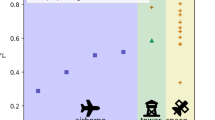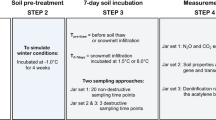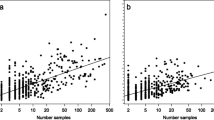Abstract
Nitrogen (N) mineralization, nutrient availability, and plant growth in the Arctic are often restricted by low temperatures. Predicted increases of cold-season temperatures may be important for plant nutrient availability and growth, given that N mineralization is also taking place during the cold season. Changing nutrient availability may be reflected in plant N and chlorophyll content and lead to increased photosynthetic capacity, plant growth, and ultimately carbon (C) assimilation by plants. In this study, we increased snow depth and thereby cold-season soil temperatures in high Arctic Svalbard in two vegetation types spanning three moisture regimes. We measured growing-season availability of ammonium (NH4 +), nitrate (NO3 −), total dissolved organic carbon (DOC) and nitrogen (TON) in soil; C, N, δ15N and chlorophyll content in Salix polaris leaves; and leaf sizes of Salix, Bistorta vivipara, and Luzula arcuata at peak season. Nutrient availability was significantly higher with increased snow depth in the two mesic meadow vegetation types, but not in the drier heath vegetation. Nitrogen concentrations and δ15N values of Salix leaves were significantly higher in all vegetation types, but the leaf sizes were unchanged. Leaves of Bistorta and Luzula were significantly larger but only significantly so in one moist vegetation type. Increased N and chlorophyll concentrations in leaves indicate a potential for increased growth (C uptake), supported by large leaf sizes for some species. Responses to cold-season soil warming are vegetation type- and species-specific, with potentially stronger responses in moister vegetation types. This study therefore highlights the contrasting effect of snow in a tundra landscape and has important implications for projections of whole tundra responses to climate change.




Similar content being viewed by others
References
ACIA (2005) Arctic climate impact assessment. Cambridge University Press, New York
Aerts R, Callaghan TV, Dorrepaal E, van Logtestijn RSP, Cornelissen JHC (2012) Seasonal climate manipulations have only minor effects on litter decomposition rates and N dynamics but strong effects on litter P dynamics of sub-arctic bog species. Oecologia 170:809–819
Bates D, Maechler M, Bolker B (2013) lme4: linear mixed-effects models using S4 classes
Berg B (2000) Litter decomposition and organic matter turnover in northern forest soils. For Ecol Manage 133:13–22
Björkman MP, Morgner E, Cooper EJ, Elberling B, Klemedtsson L, Björk RG (2010) Winter carbon dioxide effluxes from Arctic ecosystems: an overview and comparison of methodologies. Global Biogeochem Cycles 24:1–10
Cooper EJ, Dullinger S, Semenchuk P (2011) Late snowmelt delays plant development and results in lower reproductive success in the High Arctic. Plant Sci 180:157–167
Cornelissen JHC, van Bodegom PM, Aerts R et al (2007) Global negative vegetation feedback to climate warming responses of leaf litter decomposition rates in cold biomes. Ecol Lett 10:619–627
Craine JM, Elmore AJ, Aidar MPM et al (2009) Global patterns of foliar nitrogen isotopes and their relationships with climate, mycorrhizal fungi, foliar nutrient concentrations, and nitrogen availability. New Phytol 183:980–992
Elberling B, Christiansen HH, Hansen BU (2010) High nitrous oxide production from thawing permafrost. Nat Geosci 3:332–335
Epstein HE, Myers-Smith I, Walker DA (2013) Recent dynamics of arctic and sub-arctic vegetation. Environ Res Lett 8:015040
Førland EJ, Benestad R, Hanssen-Bauer I, Haugen JE, Skaugen TE (2011) Temperature and precipitation development at Svalbard 1900–2100. Adv Meteorol 2011:1–14
Gorham E (1991) Northern peatlands: role in the carbon cycle and probable responses to climatic warming. Ecol Appl 1:182–195
Grogan P, Jonasson S (2006) Ecosystem CO2 production during winter in a Swedish subarctic region: the relative importance of climate and vegetation type. Glob Change Biol 12:1479–1495
Hobbie SE (1996) Temperature and plant species control over litter decomposition in Alaskan tundra. Ecol Monogr 66:503–522
Hobbie S, Chapin FS III (1996) Winter regulation of tundra litter carbon and nitrogen dynamics. Biogeochemistry 35:327–338
Hobbie SE, Gough L (2002) Foliar and soil nutrients in tundra on glacial landscapes of contrasting ages in northern Alaska. Oecologia 131:453–462
Jonasson S, Michelsen A, Schmidt IK (1999) Coupling of nutrient cycling and carbon dynamics in the Arctic, integration of soil microbial and plant processes. Appl Soil Ecol 11:135–146
Körner C (1989) The nutritional status of plants from high altitudes. Oecologia 81:379–391
Kudo G, Nordenhaell U, Molau U (1999) Effects of snowmelt timing on leaf traits, leaf production, and shoot growth of alpine plants: comparisons along a snowmelt gradient in northern Sweden. Ecoscience 6:439–450
Larsen KS, Michelsen A, Jonasson S, Beier C, Grogan P (2012) Nitrogen uptake during fall, winter and spring differs among plant functional groups in a subarctic heath ecosystem. Ecosystems 15:927–939
Mack MC, Schuur EA, Bret-Harte MS, Shaver GR, Chapin FS III (2004) Ecosystem carbon storage in Arctic tundra reduced by long-term nutrient fertilization. Nature 431:440–443
Michelsen A, Quarmby C, Sleep D, Jonasson S (1998) Vascular plant 15N natural abundance in heath and forest tundra ecosystems is closely correlated with presence and type of mycorrhizal fungi in roots. Oecologia 115:406–418
Morgner E, Elberling B, Strebel D, Cooper EJ (2010) The importance of winter in annual ecosystem respiration in the High Arctic: effects of snow depth in two vegetation types. Polar Res 29:58–74
Nadelhoffer K, Giblin A, Shaver G, Linkins A (1992) Microbial processes and plant nutrient availability in arctic soils. In: Chapin FS III, Jefferies R, Reynolds J, Shaver GR, Svoboda J (eds) Arctic ecosystems in a changing climate: an ecophysiological perspectiveimate: an ecophysiological perspective. Academic, San Diego, pp 281–300
Nobrega S, Grogan P (2007) Deeper snow enhances winter respiration from both plant-associated and bulk soil carbon pools in birch hummock tundra. Ecosystems 10:419–431
Parsons A, Welker J, Wookey P, Press MC, Callaghan T, Lee J (1994) Growth responses of four sub-Arctic dwarf shrubs to simulated environmental change. J Ecol 82:307–318
Post W, Emanuel W, Zinke P, Stangenberger A (1982) Soil carbon pools and world life zones. Nature 298:156–159
R Development Core Team (2012) R: a language and environment for statistical computing
Rumpf SB, Semenchuk PR, Dullinger S, Cooper EJ (2014) Idiosyncratic responses of high arctic plants to changing snow regimes. PLoS One 9:e86281
Schimel JP, Bennett J (2004) Nitrogen mineralization: challenges of a changing paradigm. Ecology 85:591–602
Schimel JP, Bilbrough C, Welker JM (2004) Increased snow depth affects microbial activity and nitrogen mineralization in two Arctic tundra communities. Soil Biol Biochem 36:217–227
Semenchuk PR, Elberling B, Cooper EJ (2013) Snow cover and extreme winter warming events control flower abundance of some, but not all species in high arctic Svalbard. Ecol Evol. doi:10.1002/ece3.648
Shaver G, Chapin FS III (1980) Response to fertilization by various plant growth forms in an Alaskan tundra: nutrient accumulation and growth. Ecology 61:662–675
Sistla SA, Moore JC, Simpson RT, Gough L, Shaver GR, Schimel JP (2013) Long-term warming restructures Arctic tundra without changing net soil carbon storage. Nature 497:615–618
Solomon S, Qin D, Manning M et al (eds) (2007) Climate change 2007—the physical science basis: working group i contribution to the fourth assessment report of the intergovernmental panel on climate change. Cambridge University Press, Cambridge
Strebel D, Elberling B, Morgner E, Knicker H, Cooper EJ (2010) Cold season soil respiration in response to grazing and warming in the High Arctic Svalbard. Polar Res 29:46–57
Sturm M, Schimel JP, Michaelson G et al (2005) Winter biological processes could help convert Arctic tundra to shrubland. Bioscience 55:17–27
Sullivan PF, Welker JM (2005) Warming chambers stimulate early season growth of an arctic sedge: results of a minirhizotron field study. Oecologia 142:616–626
Tolgensbakk J, Soerbel L, Hoegvard K (2000) Adventdalen, geomorphological and quaternary geological map, Svalbard 1:100,000, Spitsbergen sheet C9Q, Norsk Polarinstitutt Temakart nr. 32. Norsk Polarinstitutt, Tromsø
Weintraub MN, Schimel JP (2003) Interactions between carbon and nitrogen mineralization and soil organic matter chemistry in Arctic tundra soils. Ecosystems 6:129–143
Welker JM, Fahnestock JT, Sullivan PF, Chimner RA (2005) Leaf mineral nutrition of Arctic plants in response to warming and deeper snow in northern Alaska. Oikos 109:167–177
Wookey P, Welker JM, Parsons A, Press MC, Callaghan TV, Lee JA (1994) Differential growth, allocation and photosynthetic responses of Polygonum viviparum to simulated environmental change at a high arctic polar semi-desert. Oikos 70:131–139
Wookey PA, Robinson CH, Parsons A, Welker JM, Press MC, Lee JA, Callaghan TV (1995) Environmental constraints on the growth, photosynthesis and reproductive development of dryas octopetala at a High Arctic polar semi-desert, Svalbard. Oecologia 102:478–489
Yano Y, Shaver GR, Giblin AE, Rastetter EB (2009) Depleted 15N in hydrolysable-N of arctic soils and its implication for mycorrhizal fungi–plant interaction. Biogeochemistry 97:183–194
Zimov S, Schuur E, Chapin FS III (2006) Permafrost and the global carbon budget. Science 312:1612–1613
Acknowledgments
Funding for this study was provided by the University of Tromsø, the University Centre in Svalbard and the Danish National Research Foundation for supporting the activities within the Center for Permafrost (CENPERM DNRF100).
Author information
Authors and Affiliations
Corresponding author
Additional information
Responsible Editor: Asmeret Asefaw Berhe.
Rights and permissions
About this article
Cite this article
Semenchuk, P.R., Elberling, B., Amtorp, C. et al. Deeper snow alters soil nutrient availability and leaf nutrient status in high Arctic tundra. Biogeochemistry 124, 81–94 (2015). https://doi.org/10.1007/s10533-015-0082-7
Received:
Accepted:
Published:
Issue Date:
DOI: https://doi.org/10.1007/s10533-015-0082-7




